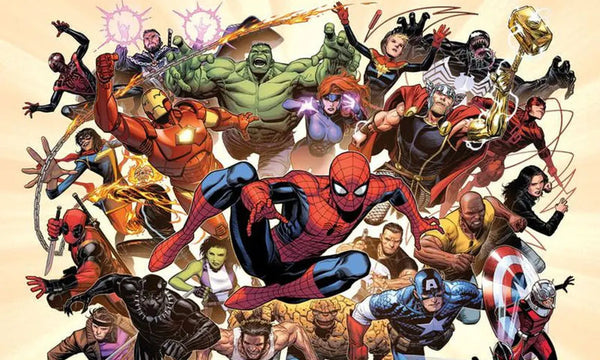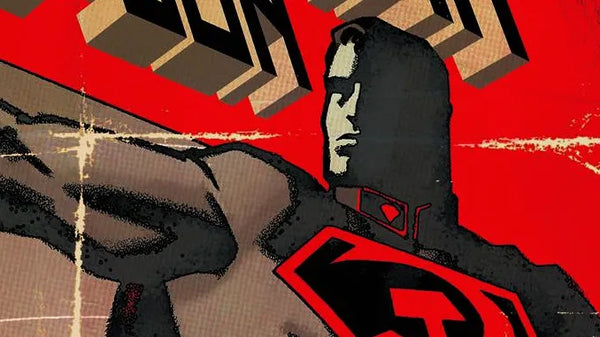Marvel counts among its characters superheroes as well known as Spider-Man, Iron Man, Captain America, Thor, Doctor Strange, Hulk, Wolverine et Captain Marvel, as well as popular superhero teams like the Avengers, X-Men, Fantastic Four, and Guardians of the Galaxy. Its stable of well-known supervillains includes characters like the Doctor Doom, Magneto, Ultron, Thanos, Green Goblin, Galactus, Loki and Kingpin. Most of Marvel's fictional characters live in a single reality, called the Marvel Universe, many of whose locations mirror real-life locations; many major characters are based in New York. Additionally, Marvel released several licensed properties from other companies. This includes the comics Star Wars twice from 1977 to 1986 and again since 2015.
The first modern comics under the Marvel Comics imprint are the science fiction anthology Journey into Mystery #69 and the teen comedy title Patsy Walker #95 (both dated June 1961), which each display an "MC on their cover. Then, in the wake of DC Comics' success in reviving superheroes in the late 1950s and early 1960s, notably with Flash, Green Lantern, Batman, Superman, Wonder Woman, Green Arrow and the other members of the Justice League of America team, Marvel is following suit.
Marvel Comics
In 1961, writer and editor Stan Lee revolutionized superhero comics by introducing superheroes designed to appeal to readers older than the medium's mostly child audience, ushering in what Marvel later called the Marvel Age of Comics. Modern Marvel's first superhero team, the titular stars of the number 1 Fantastic Four (Nov. 1961), broke convention with other comic book archetypes of the time by bickering, holding grudges both deep and petty, and avoiding anonymity or secret identities in favor of celebrity status . Afterwards, the Marvel comics gained a reputation for focusing on adult characterization and issues to a greater extent than most superhero comics before them, a quality that the new generation of older readers appreciated. This applies in particular to the title The Amazing Spider-Man, which happens to be Marvel's most popular book. Its young hero suffers from self-doubts and mundane issues like any other teenager, something many readers can relate to.

The Fantastic Four of Stan Lee and the independent designer and possible co-author Jack Kirby were born into a Cold War culture that led their creators to revise the superhero conventions of previous eras to better reflect the psychological spirit of their time. By avoiding comic book tropes like secret identities and even early costumes, having a monster as one of the heroes, and having its bickering and complaining characters in what was later called a approach "superheroes in the real world", the series represented a change that proved to be a great success.
Marvel often features flawed superheroes, monsters, and misfits, unlike the perfect, handsome, athletic heroes found in previous mainstream comics. Some marvel hero looked like villains and monsters, like Hulk and the Thing. This naturalistic approach extends even to current affairs politics.
Comics historian Mike Benton also noted:
In the world of comics Superman [of rival DC Comics], communism didn't exist. Superman rarely crosses national borders or gets involved in political disputes. From 1962 to 1965, there were more communists [in Marvel Comics] than on the subscriber list of la Pravda. Communist agents attack Ant-Man in his laboratory, red minions blow up the Fantastic Four on the moon and Vietnamese guerrillas attack Iron Man.
In addition to Spider-Man and the Fantastic Four, Marvel is beginning to release other superhero titles featuring heroes and anti-heroes such as Hulk, Thor, Ant-Man, Iron Man, X-Men, Daredevil, Inhumans, Black Panther, Doctor Strange, Captain Marvel and the Silver Surfer, as well as memorable antagonists such as the Doctor Doom, Magneto, Galactus, Loki, Green Goblin and Doctor Octopus, all existing in a shared reality known as Marvel Universe, whose locations mirror real-life cities such as New York, Los Angeles, and Chicago.

Originally, the company's publications were marked with a lowercase "Mc" in the upper right corner of the covers. However, artist and screenwriter Steve Ditko placed a larger image of The Amazing Spider-Man main character in the upper left corner of issue #2, along with the series number and price. Lee appreciated the value of this visual pattern and adapted it across the company's line of publications. This trademark template, which usually consists of a full-body shot of characters in single-player titles or a collection of the main characters' faces in ensemble titles, would become standard at Marvel for decades.
Owned by Marvel Entertainment Group
Marvel has made a lot of money with its brand of children's comics Star Comics in the 1980s and earned even more money and worldwide success during the comic book boom of the early 1990s, launching the 2099 line of comic books set in the future (Spider-Man 2099, etc.) and the creative but unsuccessful Razorline brand of superhero comic books, created by the novelist and filmmaker Clive Barker. In 1990, Marvel began selling Marvel Universe Cards with trading card manufacturer SkyBox International. These are collectible cards featuring characters and events from the Marvel Universe. The 1990s saw the appearance of different covers, cover enhancements, swimsuit issues, and company-wide crossovers that affected the overall continuity of the Marvel Universe.

To allow Marvel to expand its storytelling in the early to mid-1990s, they began experimenting with their series, including Saturday morning cartoons and various comic book collaborations to explore new genres. In 1992, the series X-Men : The Animated Series airs on Fox Kids, then Spider-Man: The Animated Series on the same channel.
Marvel Enterprises
In 1998, the company launched themarvel knights edition, which is set just outside of Marvel continuity with higher production quality. The title is led by Joe Quesada, which will soon become an editor, and offers hard and crusty stories featuring characters such as Daredevil, the Inhumans and Black Panther.
Marvel also created new brands, like MAX (an explicit content line) and Marvel Adventures (developed for children). The company also created an alternate universe, Ultimate Marvel, which allowed him to relaunch his main titles by revising and updating his characters to introduce them to a new generation.
Some of the company's properties have been adapted into successful film franchises, such as the film series Men in Black (which was based on a Malibu book), from 1997, the Blade film series, from 1998, the film series X-Men, from 2000, and the most profitable series, Spider-Man, from 2002.

The title Conan the Barbarian by Marvel was canceled in 1993 after 275 issues, while the magazine Savage Sword of Conan had lasted 235 issues. Marvel published other titles, including miniseries, through 2000, for a total of 650 issues. Conan was picked up by Dark Horse Comics three years later.
On August 31, 2009, The Walt Disney Company announced that it would acquire Marvel Comics parent company Marvel Entertainment in a cash and stock transaction worth approximately $4 billion, which, if necessary, would be adjusted at closing, giving Marvel shareholders $30 and 0.745 Disney shares for each Marvel share they owned. In 2008, Marvel and its longtime main competitor, DC Comics, shared more than 80% of the American comic book market.


0 comments